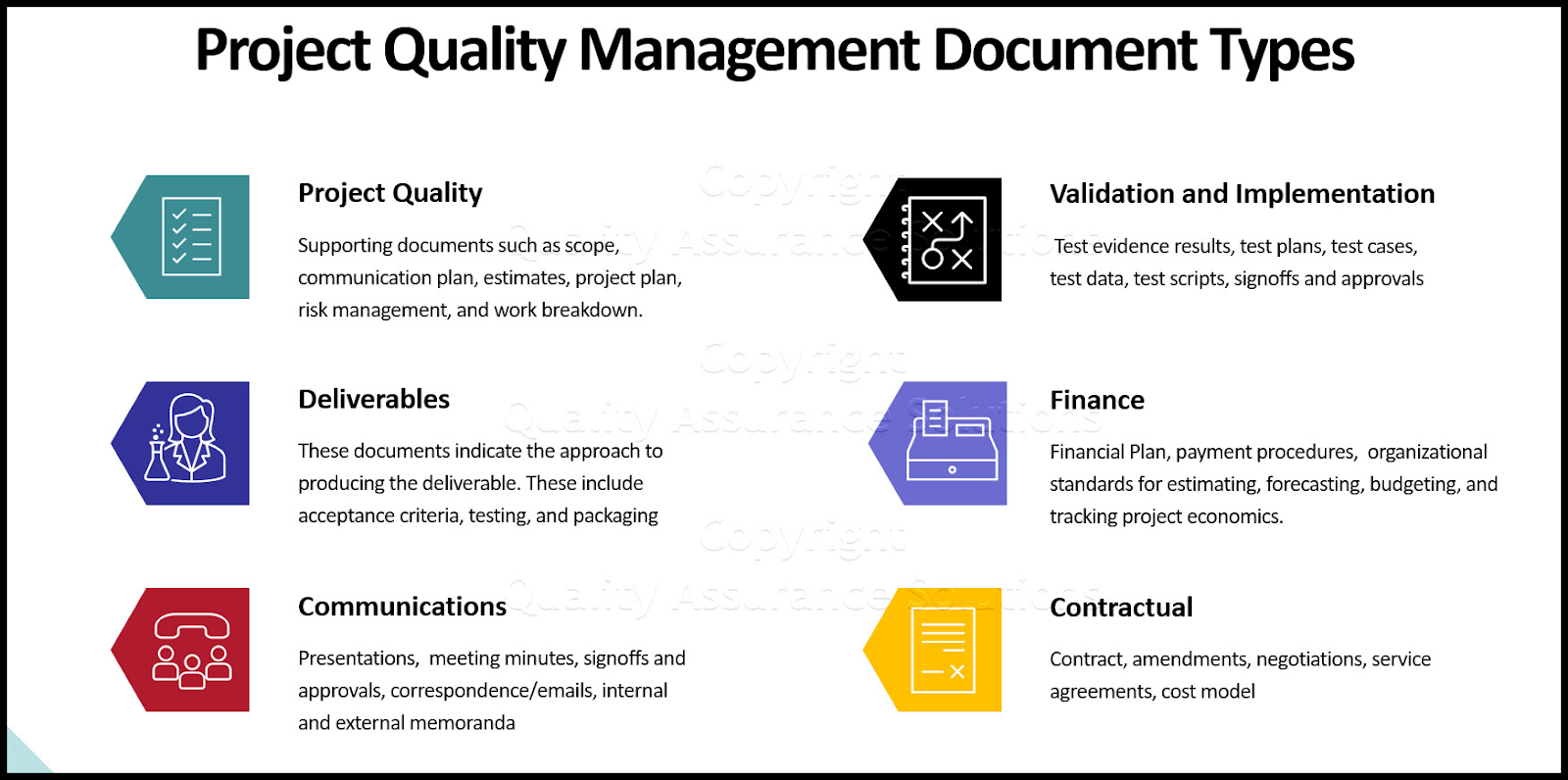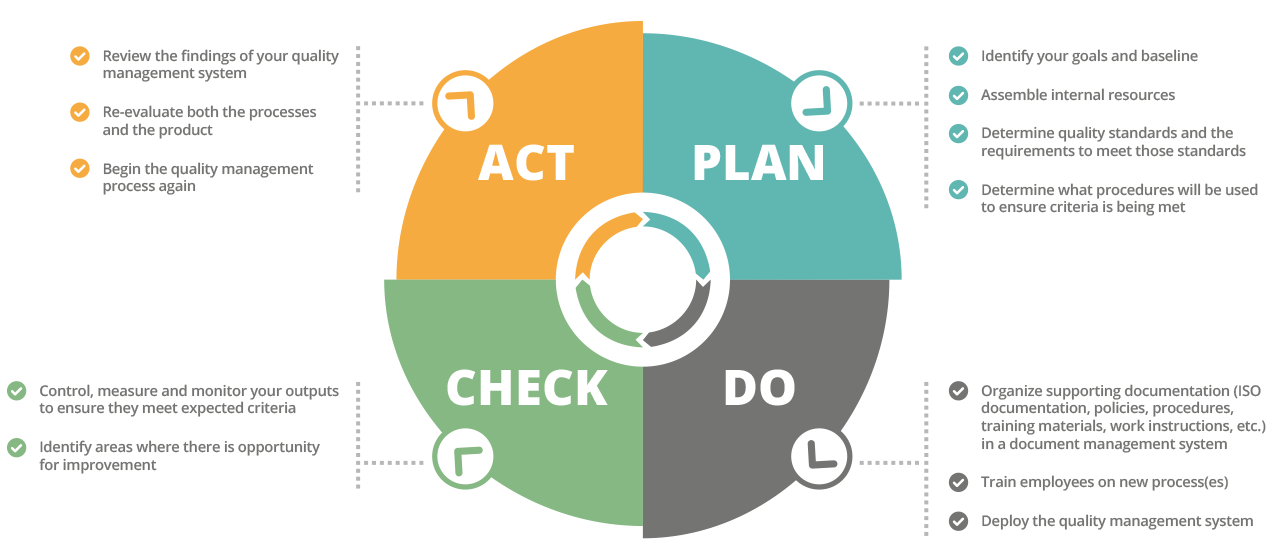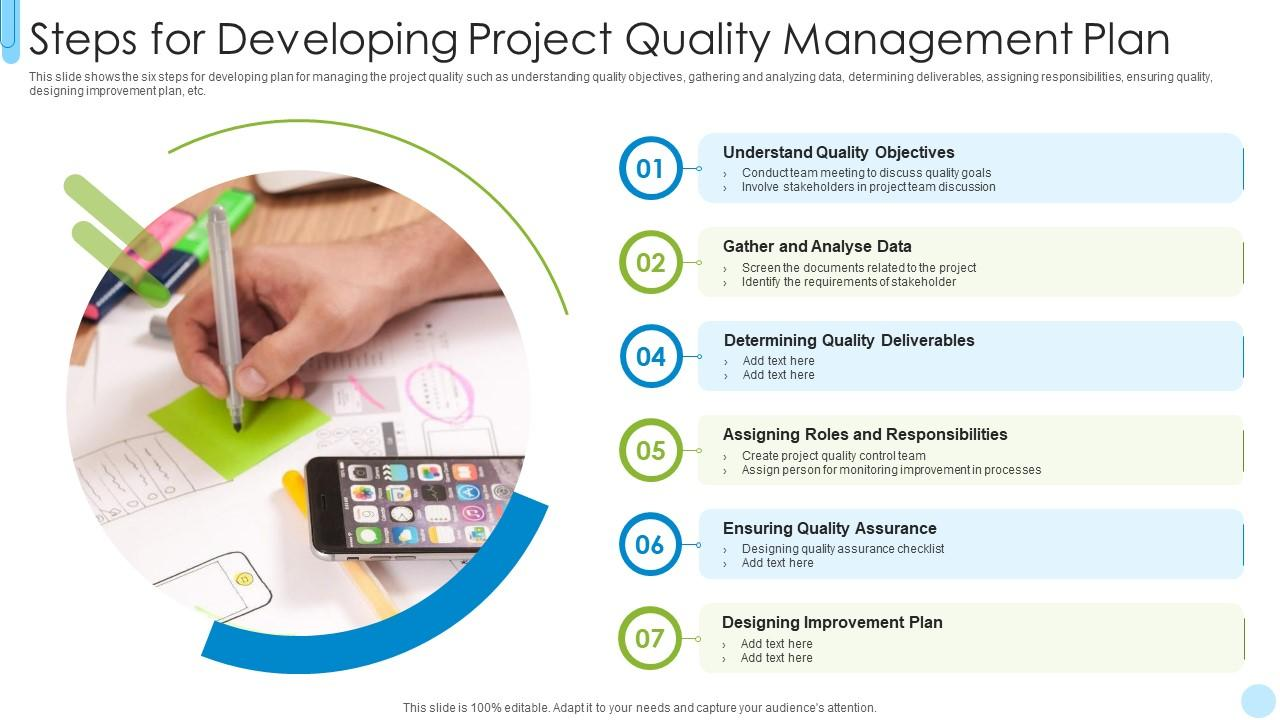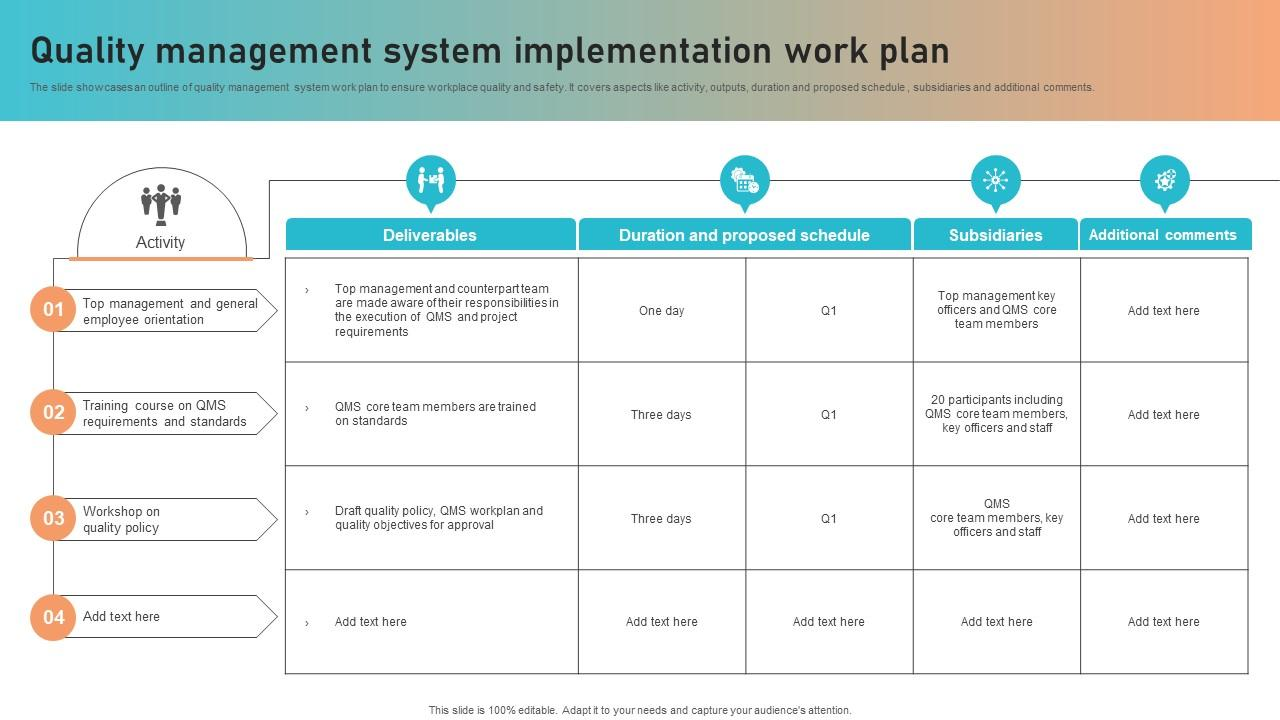Find the the importance of a well-structured quality management plan in achieving consistent quality and enhancing customer satisfaction
Developing a quality management plan is a key part of project management. It sets the process of arriving at quality objectives and standards that have to be met through the project. This sets the framework for putting in place a systematic quality management system. Quality control activities are planned as part of the system and quality assurance measures are decided upon to monitor and maintain the desired quality.
During the process, potential quality risks are identified and handled or avoided. Quality improvements and continuous improvement are the focal points in this approach and are measured through a quality review process. A number of quality parts and procedures are also included in the methodology to make this a success.
Introduction to quality management plan
The quality management plan is a critical component within project management that ensures the direction towards quality objectives and standards. It includes quality assurance and quality control activities towards monitoring the quality of project inputs and processes. A quality management system implements the quality plan for analyzing quality Consequences and establishing quality measures and improvement towards Quality standard. The methodology, procedures, and components included in this plan are critical in maintaining stringent quality standards hence calling for a Careful Quality review process of these.
Importance of a quality management plan

A quality management plan is important in project management since it outlines the quality standards, Quality Procedures as well as quality Objectives that Must be achieved For a given project. It Defines the quality control activities and provides a roadmap to ensure quality measure adheres too throughout the project lifecycle. This plan forms part of a quality management system. It therefore aims at Continuous improvement of Processes and quality enhancements of the outputs. It explains the quality methodology To Be adopted, quality Risks that might occur, and quality review process so that the quality components within the project can be controlled. Therefore, the successful implementation of the plan results in increased customer satisfaction and business success.
Ensuring consistent quality
The provision of consistent quality is a salient feature of project management. Leading quality assurance measures, such as quality control activities, are integrated within the quality management system to evaluate our performance in comparison to defined quality standards. This Not only Ensures that our quality objectives are consistent, But also points out Potential quality risks. The quality review process gives rise to continuous improvement, improvement in Efficacy Of the quality processes and also identifies possibilities for opting to take further quality enhancements.
Improving customer satisfaction
At the center of any business organization is the essence of customer satisfaction. By Applying Effective Project management Techniques and strict Quality assurance Systems, business organizations aim To achieve quality objectives, as well as to exceed customer expectations. These processes Are continually tampered with To promote continuous improvement. On-going Quality control activities Are therefore vital in seeing to it that the desired standards are attained. This Involves periodic quality reviews, with input that is used in drawing out any potential quality risks and taking the necessary quality enhancements. With a proper and updated quality management system, one can Be Assured That a Good, genuine job will be delivered Thus Enhancing customer satisfaction.
Reducing waste and increasing efficiency
Project management is very critical in cutting down on the waste spending and improving efficiency. Adherence to quality standards aids In reducing quality hazards that more likely lead to waste while The performance of Quality control activities guarantees that every task is carried out as per specified quality objectives. Important Methods of improvement include the preparation of an efficient quality management system, application of good quality practices, and acceptance of continuous improvement. This exercise not only simplifies the work but also results in significant quality improvements. Quality review process, through the application of decisive quality metrics and Quality elements, forms an essential part of A quality system. The application of the same on a project can lead to the optimization of its performance, Further Enhancing efficiency.
Key components of a quality management plan

This includes the principal areas of quality assurance and quality control activities and quality standards. It lies under the broader category of project management, which lays the foundation for the definition of quality objectives and measures to assess the performance against the stated framework. It identifies a clear methodology and process of quality review that includes activities for identification and correction of quality risks. Most important is the development of a strong quality management system which will foster improvements continuously and there will be repeated quality improvements.
Quality objectives
The focus of quality objectives in project management lays in determining whether the work has been completed according to the stated quality standards for smooth running and output. This includes quality control activities systematically to maintain uniformity and strengthen the results of the project. Robust quality assurance procedures are also inducted into the quality management system in terms of keeping a check on established quality measures and eliminating quality risks as soon as possible. These quality elements pave the way for continuous improvement, leading to overall quality improvements in the project entity. Systematic Quality review process adds strength to a positive contribution to a project's quality methodology by realigning deviations, thereby strengthening the overall quality system.
Quality assurance procedures
Our project management approach is based on a strong quality management system. What incorporates within this system are robust quality assurance procedures. These procedures include principal quality control activity objectives that strive to work in conformity with the set quality standards and objectives. A solid part of such activities is an in-depth, principal quality check and review process that will ensure the project's success. In addition to the preceding points, we take every care to introduce into our system the principle of continuous improvement. And for that, we have formulated Effective Quality improvements as part of our strategy. It is on this potent quality methodology that All quality parts are up to the mark. The quality system we follow also contains Identification And the eradication of probable quality risks, thus ensuring that project setup is a smooth affair.
Quality control techniques
Quality control techniques are an Integral Part of project management as they offer a structured way to Attain Quality objectives. To Attain Quality objectives, quality control activities might take the form of an elaborate review process, quality standards compliance, and preventive quality action. These would be implemented based on aspects of sound quality management, documented quality procedures, and an attitude to constantly improve. Quality enhancements stem from the employment of well-documented and structured quality control methodologies that aid In the identification of Quality risks. An essential characteristic of quality assurance is ensuring that quality systems and measures get often reviewed to enhance continuous enhancements.
Roles and responsibilities
Professionals assigned With The task of project management have immense responsibilities. One crucial aspect is managing quality assurance within the allotted project. This Involves conducting quality control activities, creating quality objectives, ensuring adherence to specific quality standards, and implementing quality improvements as part of the continuous improvement process.
These individuals must also be proficient in leveraging quality measures as defined in the project's quality methodology. They guide the establishment and execution of quality procedures and integrate them into the quality management system. Moreover, they mitigate Quality Risks involved, maintain quality components, and ensure an Effective Quality review process within the quality system.
All these Duties aim At Creating A successful project outcome and Meeting Clients' expectations. This detailed attention to quality procedures implies continuous learning and development in their related field of expertise.
Steps to develop a quality management plan

Steps to building a quality management plan: Define your quality's objectives explicitly and briefly by following project management principles. Create a detailed list of quality standards that the project should meet. Design a quality methodology and define all the quality control activities that can be implemented to achieve these quality standards. Implement a quality management system that will allow tracking of quality measures and quality components of the project. Create quality procedures at the beginning of your project. Identify quality risks and manage them accordingly. Last but not least, insert a continuous improvement plan. This will ensure an ongoing quality improvement process. Insert a quality review process that continuously revises the quality assurance processes and systems implemented.
Identifying quality requirements
In this stage of project management, you should be in a position to identify quality requirements. The quality standard that should be adhered to so that the project's work is accomplished as set in the goals is identified in this stage. This is where quality assurance comes in. It embarks on several quality control acts that check and validate components' functionality. Quality management system acts as a guiding tool that will lead you in a structured plan for the quality review process, procedures, and measures. Which, in turn, helps reduce quality risks. Accordingly, this will enhance continuous improvement and promote general improvements in quality in the project. An effective system of quality should incorporate a strong quality methodology. This methodology will be instrumental in setting and reaching quality goals- one of the most important steps in ensuring that the project meets or exceeds one's needs.
Developing quality assurance strategies
When developing quality assurance strategies within the realm of project management, an effective system includes well-defined quality objectives and control activities. These processes allow for efficient identification of quality risks, ensuring continuous improvement and quality improvements.
Incorporating a rigid review process and establishing stringent quality standards form essential parts of the strategy. This Contributes to optimizing the quality management system. These bullet points outline crucial quality components:
- Identification and analysis of quality risks.
- Establishment of quality objectives.
- Quality control activities and measures.
- Quality review process.
- Quality procedures and methodology.
Creating quality control measures
Effective project management requires strong quality control measures. Integrating quality assurance with quality control activities can help achieve quality objectives more efficiently. This Involves setting clear quality standards and applying a solid quality methodology to ensure all project aspects meet the set expectations.
A comprehensive quality management system is instrumental in this process. It coordinates various quality procedures and quality components to eliminate quality risks and promote continuous improvement. Regular quality review processes allow for timely quality improvements Fortifying The overall quality system.
Assigning roles and responsibilities
In project management, Roles and responsibilities must be clearly defined to promote efficiency. Project managers Are responsible for overseeing All quality control activities, ensuring compliance to quality measures and standards. They initiate the quality management system and deploy quality methodology to meet project objectives.
Quality assurance specialists assume the duty of enforcing quality objectives and procedures, With a particular focus On quality components. They also manage the quality review process, highlighting possible quality risks, and suggest quality improvements for continuous improvement.
Moreover, everyone involved in the project takes a role in maintaining the quality system, participating in quality control activities, and endorsing quality assurance for the project's success.
Implementing the quality management plan

Quality management plan Implementation forms a vital part of project management. Beginning this process involves the development of appropriate quality processes and quality metrics intended to ensure conformance to set quality standards and objectives. Embracement of stringent quality assurance, and application of quality control functions is emphasized, ensuring a functional quality system. Stringent quality review process, supported by the element of regular quality risks assessments ensures continual quality improvements. Therefore, a sustainable quality management system nurtures the culture of continuous improvement, essential to the achievement of quality elements and methodology in operations.
Training and development
In order to Ensure continuous improvement and maintain quality standards, training and development is crucial. The integration of a quality management system aids in enhancing the skills of the team in areas including quality control activities and project management.
Organizations should focus on creating structured training programs aimed at quality improvements. It's crucial to include:
- The quality objectives of the organization
- Insights on quality risks and how to mitigate them
- Effective quality procedures and quality components
Consistent training allows for adherence to quality assurance and a comprehensive quality review process, thus promoting a culture of excellence.
Monitoring and evaluation
In project management, continuous monitoring and evaluation play a crucial role in ensuring quality. It involves a chain of quality control functions that ensure conformance to set quality standards and realization of quality objectives. This is facilitated through a customized quality management system. The system enables the continuity of improvement of the project through unrelenting quality measures. This is based on a set quality methodology, composed of integral quality processes and quality elements. Potential quality risks are handled through a stringent quality review process, leading to relentless quality improvement.
Using software tools for quality management
Utilizing quality management software tools can significantly streamline project management, quality assurance, and quality control activities. These tools Are designed To meet quality standards set by various industries and assist in setting and monitoring quality objectives. Moreover, software tools can help in emphasizing a culture of continuous improvement within the organization, leading the way for consistent quality improvements.
By integrating features like quality measures, these software tools adopt a scientific quality methodology which aids in maintaining quality procedures and standardizing quality components in the quality system. They also help In Identifying And Mitigating Quality risks through a comprehensive quality review process and thereby, Enhance the overall quality management system.
Bonsai: Best project management tool in one platform

For those looking to boost their business with powerful project management, Bonsai stands out as the ultimate tool, offering efficiency, collaboration features, and simplified invoicing to help you focus on delivering exceptional results and growing your business. Bonsai is trusted by thousands of agencies and consulting firms to run their businesses daily.
Microsoft project: A comprehensive project management tool
Microsoft project is a robust project management tool extensively utilized for planning, tracking, and delivering quality assurance in various projects. It incorporates numerous quality components, such as quality objectives setting, quality control activities, and continuous improvement strategies. The tool also helps In proactively managing Potential quality risks within a project cycle.
With its advanced quality review process and Quality Management system, Microsoft projects ensure adherence to the predefined quality standards. Notable quality improvements and quality measures Are attained Through its powerful monitoring features. Consistent use of its quality procedures guarantees efficient progress towards set objectives.
Smartsheet: A tool for real-time collaboration
Smartsheet is a powerful tool for project management and real-time collaboration. It encompasses quality components necessary for managing tasks, ensuring quality assurance and carrying out quality control activities. The platform facilitates a robust quality review process, adhering to quality standards while Keeping quality objectives in focus.
Adopting a dynamic quality management system, smartsheet is committed to continuous improvement and encourages quality improvements through its user-friendly interface. The tool Not only Identifies potential quality risks But also Introduces effective quality measures. The utilization of Smartsheet facilitates a seamless integration of quality methodology and quality procedures in managing collaboration projects.
Wrike: A tool for streamlined workflow
Wrike is an effective tool for project management, aiding in quality assurance and quality control activities. It helps In establishing quality standards, setting Quality objectives, and Ensuring Continuous improvement. Wrike's features help businesses streamline their workflow while achieving quality improvements.
Wrike's quality measures and procedures help in minimizing quality risks. This quality methodology ensures a thorough quality review process. Furthermore, wrike's quality management system aids in implementing a quality system that aligns with your organization's needs.
Challenges in developing a quality management plan

Designing the quality management plan has some challenges. One of the most considerable tasks is applying the right quality standards for the project management process. Finding the best quality measures has greater complexities due to the variability in project natures. Besides, ensuring effective quality control activities consistently throughout the project lifecycle adds to the complexity. Another critical challenge is to integrate the quality objectives into framing the total quality management system. Therefore, it is important to uphold a comprehensive quality assurance approach that involves conformity to the established standards. Promoting a culture of continuous improvement can also be very challenging, yet it is the mainstay for sustainable quality improvements.
Aligning quality goals with business objectives
Quality objectives have to be in line with business goals for sound project management. This is brought about by progressive quality assurance, which has to be put in place, the implementation of quality control activities, and adherence to quality standards. Putting in place a robust quality management system upholds continuous improvement and quality improvements across all business functions. It involves establishing precise quality measures, using a well-defined quality methodology, and applying strict quality procedures. The quality system infrastructure also involves well-thought-out quality components to mitigate quality risks and a quality review process. The ultimate goal is better service or products for the customers.
Ensuring employee engagement
Ensuring employee engagement is key in any organization, especially when it comes to implementing project management and quality assurance effectively. An engaged workforce can significantly contribute to upholding quality standards and successfully achieving the quality objectives of the company. This activeness can further result in continuous improvement and enhance the quality of operations. The development and use of quality measures and an active quality management system can also ensure the maintenance of employee engagement. The system comprises quality control activities, quality components, and quality procedures, among many others. These elements can reduce the chances of quality risks while enhancing regular quality review processes.
Conclusion: The value of a well-developed quality management plan
In summary, a well-developed quality management plan is of great importance in managing a project. It ensures uniformity in quality standards and further assures that quality control activities can be successful. The quality improvement objectives are met, ensuring quality improvements in the project. These measures lessen the possibility of quality risks and enhance a successful quality review system. Thus, a robust quality management system is crucial for the overall success of any project.






